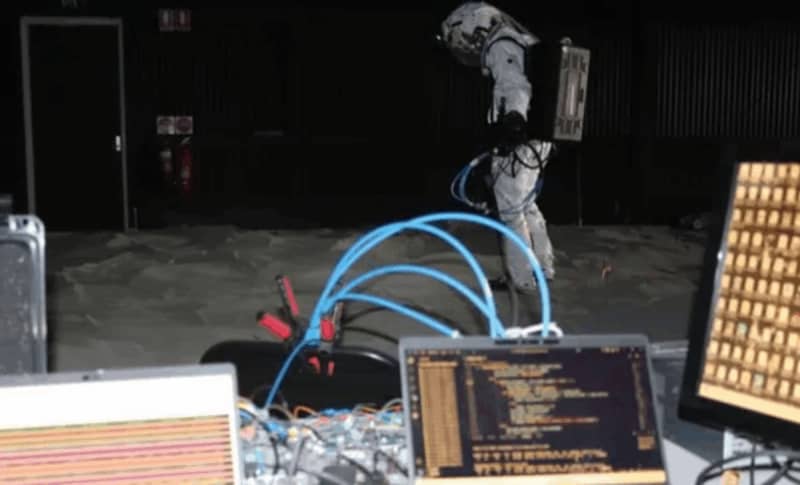
Image credit: Dr Emanuele Pulvirenti | The Daily Galaxy –Great Discoveries Channel
Astronauts face significant challenges while moving in spacesuits due to the resistance created by their pressurization. A new exosuit, tested in a simulated lunar environment, is aiming to address these mobility issues. The suit, featuring innovative artificial muscles, could make it easier for astronauts to explore the Moon and Mars. This cutting-edge technology is the focus of a recent study, highlighting the potential for future advancements in wearable robotic systems.
The Robotic Exosuit: A Breakthrough for Space Exploration
[Astronauts ](https://dailygalaxy.com/2025/11/chi…

Image credit: Dr Emanuele Pulvirenti | The Daily Galaxy –Great Discoveries Channel
Astronauts face significant challenges while moving in spacesuits due to the resistance created by their pressurization. A new exosuit, tested in a simulated lunar environment, is aiming to address these mobility issues. The suit, featuring innovative artificial muscles, could make it easier for astronauts to explore the Moon and Mars. This cutting-edge technology is the focus of a recent study, highlighting the potential for future advancements in wearable robotic systems.
The Robotic Exosuit: A Breakthrough for Space Exploration
Astronauts have long struggled with the physical limitations imposed by spacesuits. While they provide life-sustaining protection in the harsh vacuum of space, these suits are bulky and stiff, making even simple movements exhausting.** The introduction of an exosuit** designed to work under a spacesuit could revolutionize how astronauts perform tasks on planetary surfaces. This new exosuit, tested during a space analog mission in Australia, features artificial muscles that can assist movement, offering a solution to the inherent resistance spacesuits impose.
Designed by Dr. Emanuele Pulvirenti, a research associate at the University of Bristol, this suit is not just a theoretical idea. It’s a practical development aimed at addressing real-world challenges in space exploration. As Pulvirenti explained,
“The hope is that this technology could pave the way for future wearable robotic systems that enhance astronaut performance and reduce fatigue during extravehicular surface activities.”
These benefits are critical for future missions to the Moon and Mars, where astronauts will need to perform complex tasks over extended periods in harsh environments.
The Study: How the Exosuit Was Tested
The exosuit was put to the test during the ADAMA simulation mission, a two-week experiment held in Adelaide, Australia. This mission is a part of an ongoing effort to simulate conditions astronauts will encounter on the Moon and Mars. In this controlled environment, researchers observed how the exosuit influenced astronauts’ movements while they wore it underneath their spacesuits.
According to the University of Bristol, the exosuit’s design features artificial muscles that help reduce the strain of moving in a spacesuit. These artificial muscles are crafted from advanced materials, including nylon and thermoplastic layers for flexibility and airtight functionality, and Kevlar straps for added strength and durability. The tests conducted in Australia were designed to assess the suit’s effectiveness in helping astronauts walk, climb, and carry objects, all crucial activities for surface exploration.
The analog mission, held at the CRATER facility in Roseworthy, Australia, simulated the unique lighting and terrain found on the Moon. The results of the trial showed that astronauts wearing the exosuit were able to move more easily, with significantly reduced physical fatigue compared to those without the additional suit layer. These findings are a major step forward in developing more practical space gear for future missions.
The Technology Behind the Exosuit: Artificial Muscles and More
At the core of the exosuit is its artificial muscle system, designed to **mimic the movements of the human body **while providing support. This system is built to work seamlessly with the astronaut’s own motions, enhancing strength and reducing the energy required to perform strenuous tasks. The suit is made up of two layers: the outer nylon layer for flexibility and a thermoplastic layer inside, ensuring airtight properties essential for use in space environments.
The integration of Kevlar into key areas, such as the knee straps and waistband, provides additional strength to withstand the tension that astronauts will experience while walking or climbing on rocky, uneven terrain. The suit is engineered not only for durability but also for comfort. Astronauts testing the exosuit in the Australian analog mission reported improved mobility and less strain on their joints, crucial for activities that could otherwise lead to muscle fatigue during long missions on the Moon or Mars.
The Bigger Picture: Exosuits for Everyday Use
While the exosuit’s immediate application is in space exploration, Pulvirenti’s vision extends beyond space missions. The technology could eventually benefit people on Earth, particularly those with mobility challenges. The next goal is to develop a hybrid version of the suit that can switch between assistance and resistance modes, providing customizable support to individuals with disabilities or those undergoing physical rehabilitation.

Image
The potential for this technology to serve both space exploration and medical rehabilitation is vast. As Pulvirenti noted,
“Our next goal is to create a hybrid suit that can switch between assistance and resistance modes as needed, which could be of great benefit for people in need of support with mobility, going through physical rehabilitation.”
This adaptability opens up exciting possibilities for the broader application of the technology in everyday life.
Enjoyed this article? Subscribe to our free newsletter for engaging stories, exclusive content, and the latest news.